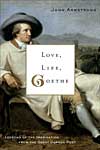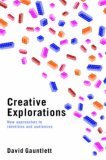July 26, 2007
Love, Life, Goethe: Lessons of the Imagination from the Great German Poet by John Armstrong
by John Armstrong
I don’t often read biographies, so this is not a book I would ordinarily pick up, but since it was there on my local library’s new book shelf, with the subtitle’s promise of “lessons of the imagination,” I took it home and found it to be very readable. (Nice short chapters for one thing.)

Goethe is seen as an example of the reconciliation of life and art; he is able to say that life is good, while still striving to develop himself. (‘I am not here simply to have a good time, but to devote myself to noble objects.’ p. 178)
Goethe is determined to bridge the gaps between creative art and what is called ‘the real world.’ For much of the nineteenth and twentieth centuries artists have withdrawn their sympathy from the normal conditions of comfortable existence. The artist is at odds with – and critical of ‘bourgeois life.’ …
Goethe’s immense hope was that there need not be – should not be – a spiritual loathing or artistic contempt for that life. Which, after all, is normal life, broadly speaking. If depth of thought, maturity of passion and grace of feeling are to be central to a society, these spiritual qualities have to coexist with the normal demands of life. And Goethe suggests more than coexistence; he is looking at the ways in which the discipline of ‘the real world’ – the demands of power and responsibility – might actually offer special opportunities for personal growth and development. (p. 101)
Another edition has the subtitle “how to be happy in an imperfect world.” Google Book Search page for this title has links to several reviews.
Comments (0)
- culture,happiness
July 25, 2007
Creative Explorations: New Approaches to Identities and Audiences by David Gauntlett is based on a project in which people used Lego pieces to create metaphorical models of their identity (sounds something like “sand tray therapy“).
by David Gauntlett is based on a project in which people used Lego pieces to create metaphorical models of their identity (sounds something like “sand tray therapy“).
The author has posted an extract from the conclusion; here is part:
“I was struck by ‘the will to coherence’ – the desire to assemble a solid and unified view of self-identity. It was also possible to see participants asserting their own distinctiveness within the context of an increasingly globalised and mainstream fashion-led culture. The role of the media emerged as the provider of stories – ethical resources which people use to orient themselves towards aspirations. We saw that the sense of a journey was common, with each person as the hero of their own story, often moving away from historical ties towards greater stability, fulfilment, and engagement with the world. … these goals were not about possessions gained, but about social connections, inner happiness, and a life well lived.”
More on the project at the ArtLab website… and the author’s website….
Comments (1)
- new books,self
July 21, 2007
To achieve holism we must try to connect up all the fragments of our different thoughts and draw them into a living whole, and in so doing we enrich the meaning of each individual element. ‘We are aware of a huge crowd of things; the soul can grasp extraordinarily diverse links between these things. Souls that have the inner strength to open up the world begin to organize these links, so as to think more easily; and they begin to take pleasure in putting two and two together and establishing connections between diverse elements of their world.’ (p. 307)
The above passage from Love, Life, Goethe: Lessons of the Imagination from the Great German Poet resonated unexpectedly with ‘Everything Is Miscellaneous.’
resonated unexpectedly with ‘Everything Is Miscellaneous.’
Comments (0)
- culture
by John Armstrong





